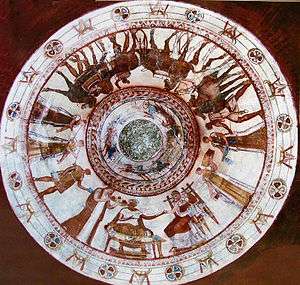Thrace
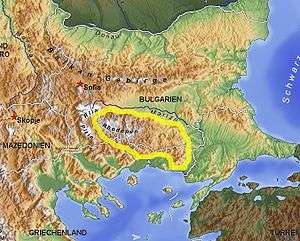
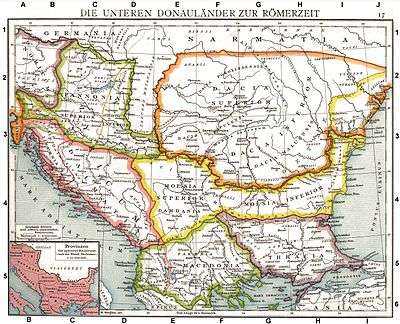
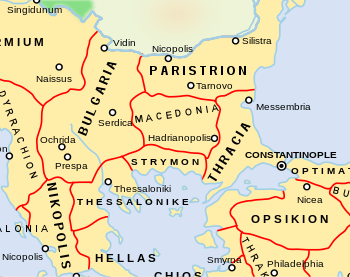
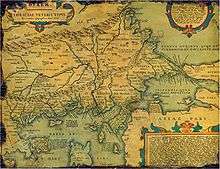
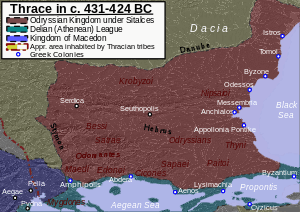
Thrace (/ˈθreɪs/; Modern Greek: Θράκη, Thráke; Bulgarian: Тракия, Trakiya; Turkish: Trakya) is a historical and geographic area in southeast Europe, centered on the modern borders of Bulgaria, Greece, and Turkey.[1] In antiquity, it was also referred to as Europe, prior to the extension of the term to describe the whole continent.[1] As a geographical concept, Thrace designates a region bounded by the Balkan Mountains on the north, Rhodope Mountains and the Aegean Sea on the south, and by the Black Sea and the Sea of Marmara on the east. The areas it comprises are southeastern Bulgaria (Northern Thrace), northeastern Greece (Western Thrace), and the European part of Turkey (Eastern Thrace). The biggest part of Thrace is part of present-day Bulgaria. In Turkey, it is also called Rumeli. The name comes from the Thracians, an ancient Indo-European people inhabiting Southeastern Europe.
Etymology
The word itself was established by the Greeks for referring to the Thracian tribes, from Ancient Greek Thrake (Θρᾴκη),[2] descending from Thrāix (Θρᾷξ).[3] The name of the continent Europe first referred to Thrace proper, prior to extending its meaning to the whole continent.[1] The region obviously took the name of the principal river there, Hebros, probably from the Indo-European arg "white river" (the opposite of Vardar, meaning "black river"),[4] according to an alternative theory, Hebros means "goat" in Thracian.[5]
Mythology
The name appears to derive from an ancient heroine and sorceress Thrace, who was the daughter of Oceanus and Parthenope, and sister of Europa.
Geography
Borders
The historical boundaries of Thrace have varied. The ancient Greeks employed the term "Thrace" to refer to all of the territory which lay north of Thessaly inhabited by the Thracians,[6] a region which "had no definite boundaries" and to which other regions (like Macedonia and even Scythia) were added.[7] In one ancient Greek source, the very Earth is divided into "Asia, Libya, Europa and Thracia".[7] As the Greeks gained knowledge of world geography, "Thrace" came to designate the area bordered by the Danube on the north, by the Euxine Sea (Black Sea) on the east, by northern Macedonia in the south and by Illyria to the west.[7] This largely coincided with the Thracian Odrysian kingdom, whose borders varied over time. After the Macedonian conquest, this region's former border with Macedonia was shifted from the Struma River to the Mesta River.[8][9] This usage lasted until the Roman conquest. Henceforth, (classical) Thrace referred only to the tract of land largely covering the same extent of space as the modern geographical region. In its early period, the Roman province of Thrace was of this extent, but after the administrative reforms of the late 3rd century, Thracia's much reduced territory became the six small provinces which constituted the Diocese of Thrace. The medieval Byzantine theme of Thrace contained only what today is Eastern Thrace.
Cities of Thrace
The largest cities of Thrace are: Byzantium (İstanbul), Plovdiv, Burgas, Stara Zagora, Haskovo, Komotini, Alexandroupoli, Edirne, Çorlu and Tekirdağ.
Demographics and religion
Most of the Bulgarian and Greek population are Christians, while most of the Turkish inhabitants of Thrace are Muslims.
Thrace in ancient Greek mythology
Ancient Greek mythology provides them with a mythical ancestor, named Thrax, son of the war-god Ares, who was said to reside in Thrace. The Thracians appear in Homer's Iliad as Trojan allies, led by Acamas and Peiros. Later in the Iliad, Rhesus, another Thracian king, makes an appearance. Cisseus, father-in-law to the Trojan elder Antenor, is also given as a Thracian king. Homeric Thrace was vaguely defined, and stretched from the River Axios in the west to the Hellespont and Black Sea in the east. The Catalogue of Ships mentions three separate contingents from Thrace: Thracians led by Acamas and Peiros, from Aenus; Cicones led by Euphemus, from southern Thrace, near Ismaros; and from the city of Sestus, on the Thracian (northern) side of the Hellespont, which formed part of the contingent led by Asius. Greek mythology is replete with Thracian kings, including Diomedes, Tereus, Lycurgus, Phineus, Tegyrius, Eumolpus, Polymnestor, Poltys, and Oeagrus (father of Orpheus). In addition to the tribe that Homer calls Thracians, ancient Thrace was home to numerous other tribes, such as the Edones, Bisaltae, Cicones, and Bistones.
Thrace is also mentioned in Ovid's Metamorphoses in the episode of Philomela, Procne, and Tereus. Tereus, the King of Thrace, lusts after his sister-in-law, Philomela. He kidnaps her, holds her captive, rapes her, and cuts out her tongue. Philomela manages to get free, however. She and her sister, Procne, plot to get revenge, by killing Itys (son of Tereus and Procne) and serving him to his father for dinner. At the end of the myth, all three turn into birds – Procne, a swallow; Philomela, a nightingale; and Tereus, a hoopoe.
History
Ancient and Roman history
The indigenous population of Thrace was a people called the Thracians, divided into numerous tribal groups. The region was controlled by the Persian Empire at its greatest extent,[10] and Thracian soldiers were known to be used in the Persian armies. Later on, Thracian troops were known to accompany neighboring ruler Alexander the Great when he crossed the Hellespont which abuts Thrace, during the invasion of the Persian Empire itself.
The Thracians did not describe themselves by name; terms such as Thrace and Thracians are simply the names given them by the Greeks.[11]
Divided into separate tribes, the Thracians did not form any lasting political organizations until the founding of the Odrysian state in the 4th century BC. Like Illyrians, the locally ruled Thracian tribes of the mountainous regions maintained a warrior tradition, while the tribes based in the plains were purportedly more peaceable. Recently discovered funeral mounds in Bulgaria suggest that Thracian kings did rule regions of Thrace with distinct Thracian national identity.
During this period, a subculture of celibate ascetics called the Ctistae lived in Thrace, where they served as philosophers, priests and prophets.
Sections of Thrace particularly in the south started to become hellenized before the Peloponnesian War as a significant amount of Athenian and Ionian colonies were set up in Thrace before the war and Spartan and other Doric colonists followed suit after the war. The special interest of Athens to Thrace is underlined by the numerous finds of Athenian silverware in Thracian tombs.[12] In 168 BC, after the Third Macedonian war and the subjugation of Macedonia to the Romans, Thrace also lost its independence and became tributary to Rome. Towards the end of the 1st century BC Thrace lost its status as a client kingdom as the Romans began to directly appoint their kings. [13] This situation lasted until 46 AD, when the Romans finally turned Thrace into a Roman province (Romana provincia Thracia)[14]
During the Roman domination, within the geographical borders of ancient Thrace, there were two separate Roman provinces, namely Thrace ("provincia Thracia") and Lower Moesia ("Moesia inferior"). Later, in the times of Diocletian, the two provinces were joined and formed the so-called "Dioecesis Thracia".[15] The establishment of Roman colonies and mostly several Greek cities, as was Nicopolis, Topeiros, Traianoupolis, Plotinoupolis and Hadrianoupolis resulted from the Roman Empire's urbanization. It is noteworthy that the Roman provincial policy in Thrace favored mainly not the Romanization but the Hellenization of the country, which had started as early as the Archaic period through the Greek colonisation and was completed by the end of Roman Antiquity.[16] As regards the competition between the Greek and Latin language, the very high rate of Greek inscriptions in Thrace extending south of Haemus mountains proves the complete language Hellenization of this region. The boundaries between the Greek and Latin speaking Thrace are placed just above the northern foothills of Haemus mountains.[17]
Medieval history
By the mid 5th century, as the Western Roman Empire began to crumble, Thracia fell from the authority of Rome and into the hands of Germanic tribal rulers. With the fall of the Western Roman Empire, Thracia turned into a battleground territory for the better part of the next 1,000 years. The surviving eastern portion of the Roman Empire in the Balkans, later known as the Byzantine Empire, retained control over Thrace until the 8th century when the northern half of the entire region was incorporated into the First Bulgarian Empire and the remainder was reorganized in the Thracian theme. The Empire regained the lost regions in the late 10th century until the Bulgarians regained control of the northern half at the end of the 12th century. Throughout the 13th century and the first half of the 14th century, the region was changing in the hands of the Bulgarian and the Byzantine Empire (excluding Constantinople). In 1265 the area suffered a Mongol raid from the Golden Horde, led by Nogai Khan, and between 1305 and 1307 was raided by the Catalan company.[18]
Ottoman period
.svg.png)
In 1352, the Ottoman Turks conducted their first incursion into the region subduing it completely within a matter of two decades and occupying it for five centuries. In 1821, several parts of Thrace, such as Lavara, Maroneia, Sozopolis, Aenos, Callipolis and Samothraki rebelled during the Greek War of Independence.
Modern history

With the Congress of Berlin in 1878, Northern Thrace was incorporated into the semi-autonomous Ottoman province of Eastern Rumelia, which united with Bulgaria in 1885. The rest of Thrace was divided among Bulgaria, Greece and Turkey at the beginning of the 20th century, following the Balkan Wars, World War I and the Greco-Turkish War. Today, Thracian is a geographical term used in Greece, Turkey and Bulgaria.
Famous Thracians and people from Thrace
- Orpheus was, in Ancient Greek mythology, the chief representative of the art of song and playing the lyre.
- Protagoras was a Greek philosopher from Abdera, Thrace (c. 490–420 BC.) An expert in rhetorics and subjects connected to virtue and political life, often regarded as the first sophist. He is known primarily for three claims: (1) that man is the measure of all things, often interpreted as a sort of moral relativism, (2) that he could make the "worse (or weaker) argument appear the better (or stronger)" (see Sophism), and (3) that one could not tell if the gods existed or not (see Agnosticism).
- Herodicus was a Greek physician of the fifth century BC who is considered the founder of sports medicine. He is believed to have been one of Hippocrates' tutors.
- Democritus was a Greek philosopher and mathematician from Abdera, Thrace (c. 460–370 BC.) His main contribution is the atomic theory, the belief that all matter is made up of various imperishable indivisible elements which he called atoms.
- Spartacus was a Thracian who led a large slave uprising in what is now Italy in 73–71 BC. His army of escaped gladiators and slaves defeated several Roman legions in what is known as the Third Servile War.
- A number of Roman emperors of the 3rd–5th century were of Thraco-Roman backgrounds (Maximinus Thrax, Licinius, Galerius, Aureolus, Leo the Thracian, etc.). These emperors were elevated via a military career, from the condition of common soldiers in one of the Roman legions to the foremost positions of political power.
Thracians and wine
Thrace has been producing wine for the last 5000 years. Thracians may have had a cult for the drink, as evident from the worship of Dionysus. Ancient sources suggest that Thracians were among the best winemakers. According to some theories, the first vines in Europe were brought from the Middle East and planted in what is now Southern Bulgaria. At the beginning wine was produced along the Maritsa river and around seaports.
Semele is a Thracian goddess, mother of Dionysus. The name is associated with Phrygian word meaning "mother earth" and the old Bulgarian “Землia” (Earth). One of the stories about Semele says that the goddess got pregnant from Zeus. When Hera found out she called the Thracian tribes and ordered them to extract the baby from his mother’s womb and burn it. According to the story, vines grew out of the ashes. [Semele was not a goddess. She was a priestess of Zeus.]
Other myths associate the beginning of wine production with the Thracians. According to Homer, the most popular wine in his time was the kind from Maroneia, a city in Thrace. Odysseus used this wine to put the Cyclops to sleep before he speared the eye of Polyphemus. Another Thracian myth tells the story of Orestes and his dog Sirius. According to the story, Sirius gave birth to a piece of wood, which Orestes buried into the ground. The next spring it sprouted out in the first vine.
The Thracians had a well-developed viticulture, which Slavs and Bulgars inherited and developed when they came to the Balkans. After Christianization, the Dionysus’ cult faded away. Although its feast was regulated by the Orthodox Church, rituals like those of Saint Trifon and Trifon Zarezan have much in common with the cult of Dionysus: for example, pouring wine and electing a pretend-king. The days of celebration of both holidays are the same. During the Middle Ages the Church took wine production under its protection.
Thracian gods
Two main gods of the Bessi Thracians were Dionysus (worshiped as Zagreus) and Bendis. Zagreus was worshipped by followers of Orphism (the name given to a set of religious beliefs and practices associated with literature ascribed to the mythical poet Orpheus), whose late Orphic hymns invoke his name. Actually Zagreus was a Thracian god prototype later known as Dionysus – the god of joy, wine and ecstasy in the Greek and Bacchus in the Roman mythology.
Holidays (mysteries) dedicated to Dionysus in Greece were called Dionysii; in Rome they were known as Bacchanalia and in Thrace as Rozalii. Orphic mysteries held in honor of Dionysus-Zagreus were performed only by devoted unmarried men. They were called a-bii, which means "not alive" because they did not lead an ordinary life. The mysteries were held in secret places far from the eyes of the ordinary people and were accompanied by choral songs and mimic games. The culmination of the mysteries was the symbolic death of the king-priest, identified with Zagreus who according to myth was torn apart by the Titans. Following the "death", the mother goddess was also symbolically born. The first part was carried out through a sacrifice of a bull, horse, goat or even people and the latter through a sexual orgy. Later on, Orphic mysteries became a part of the Bacchanalia.
Wine and fire were essential to the cult of Dionysus. The act of wine producing itself was recognized as a tale of the life and sorrow of the god. Picking and smashing the vines represent the way that the Titans tore Dionysus apart. That is why vinification was a mystery that was accompanied by sad songs.
Bendis was a goddess worshiped in Southwestern Thrace. She was typically presented as a hunter, wrapped with leather with boots and a fox fur hat. She holds a spear, a bow or a net and she is often accompanied by a hunting dog. In Greek mythology boots are a symbol of speed. Bendis is different from her Greek analogies in that she wears a fox hat.
Vine and Haberlea rhodopensis (Orpheus' flower) were objects of cult for the Bessi. Wine and flame were believed to cause euphoria. Svetonii Tranquil and Herodotus described rituals in which worshippers would divine by pouring wine on the altar and observing the height of the blaze. Other tribes would also burn a sacrificial animal on the altar. They believed that if the flames were vigorous, the year would be fruitful.
Legacy
The Trakiya Heights in Antarctica "are named after the historical region."[19]
See also
- 1934 Thrace Pogroms
- 1989 expulsion of Turks from Bulgaria
- Celtic settlement of Eastern Europe
- Dacia
- Dardania
- Macedon
- Moesia
- Moesogoths
- Music of Thrace
- Paionia
- The Destruction of Thracian Bulgarians in 1913
- Turkish Republic of Thrace
- Turks of Western Thrace
Notes
- 1 2 3 BBC
- ↑ Θρᾴκη. Liddell, Henry George; Scott, Robert; A Greek–English Lexicon at the Perseus Project
- ↑ Θρᾷξ. Liddell, Henry George; Scott, Robert; A Greek–English Lexicon at the Perseus Project
- ↑ Pieter, Jan. Thracians and Mycenaeans: Proceedings of the Fourth International Congress.
- ↑ "The Plovdiv Project".
- ↑ Swinburne Carr, Thomas. The history and geography of Greece. p. 56.
- 1 2 3 Smith, Sir William (1857). Dictionary of Greek and Roman geography. London. p. 1176.
- ↑ Johann Joachim Eschenburg, Nathan Welby Fiske. Manual of classical literature. p. 20 n.
- ↑ Adam, Alexander. A summary of geography and history, both ancient and modern. p. 344.
- ↑ Joseph Roisman,Ian Worthington. "A companion to Ancient Macedonia" John Wiley & Sons, 2011. ISBN 144435163X p 343
- ↑ The Cambridge Ancient History, Volume 3, Part 2: The Assyrian and Babylonian Empires and Other States of the Near East, from the Eighth to the Sixth Centuries BC by John Boardman, I. E. S. Edwards, E. Sollberger, and N. G. L. Hammond ,ISBN 0-521-22717-8,1992,page 597: "We have no way of knowing what the Thracians called themselves and if indeed they had a common name...Thus the name of Thracians and that of their country were given by the Greeks to a group of tribes occupying the territory..."
- ↑ A. Sideris, Theseus in Thrace. The Silver Lining on the Clouds of the Athenian-Thracian Relations in the 5th Century BC (Sofia 2015), pp. 13-14, 79-82.
- ↑ D. C. Samsaris, Le royaume client thrace aux temps de Tibere et la tutelle romaine de Trebellenus Rufus (Le stade transitif de la clientele a la provincialisation de la Thrace), Dodona 17 (1), 1988, p. 159-168
- ↑ D. C. Samsaris, The Hellenization of Thrace during the Greek and Roman Antiquity (Diss. in Greek), Thessaloniki 1980, p. 26-36
- ↑ D. C. Samsaris, Historical Geography of Western Thrace during the Roman Antiquity (in Greek), Thessaloniki 2005, p. 7-14
- ↑ D. C. Samsaris, The Hellenization of Thrace, passim
- ↑ D. C. Samsaris, The Hellenization of Thrace, p. 320-330
- ↑ La Venjança catalana. Gran Enciclopèdia Catalana.
- ↑ Trakiya Heights. SCAR Composite Antarctic Gazetteer.
References
- Hoddinott, R. F., The Thracians, 1981.
- Ilieva, Sonya, Thracology, 2001
External links
| Wikivoyage has a travel guide for Thrace. |
| Wikimedia Commons has media related to Ancient Thrace and Ancient Thracians. |
- Ethnological Museum of Thrace, comprehensive website on Thracian history and culture.
- Bulgaria's Thracian Heritage. including images of the comprehensive art collection of Thracian gold found on the territory of contemporary Bulgaria.
- Information on Ancient Thrace
- The People of the God-Sun Ar and Areia (modern Thrace)
Coordinates: 42°N 26°E / 42°N 26°E

